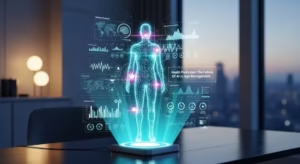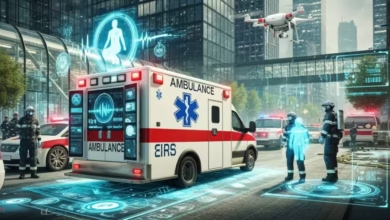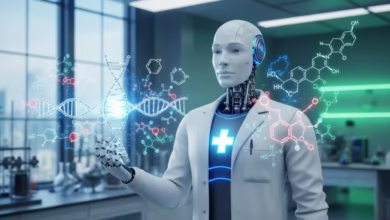AI and Aging: Can Technology Extend Human Life?

The blog post AI and Aging: Can Technology Extend Human Life? explores the intricate relationship between AI and longevity. It delves into how life extension AI technologies are being developed to combat age-related diseases, thereby potentially prolonging human life. The article highlights advancements in health prediction models that leverage AI to enhance age management, offering insights into tools that can predict health outcomes as individuals age. Lastly, it provides actionable insights for integrating AI into longevity practices, empowering readers to adopt innovations that could positively impact their health span. Overall, the article emphasizes the hopeful potential of AI and longevity in reshaping the future of aging.
Exploring The Connection Between AI And Longevity

The intersection of AI and longevity is a rapidly evolving field that holds promise for extending human life and enhancing the quality of aging. With advancements in technology, particularly in artificial intelligence, researchers are beginning to unravel the complexities of biological aging. AI systems can analyze vast datasets, identify patterns, and provide insights that were previously unattainable, leading to breakthroughs in understanding how we age and how longevity can be achieved.
Key Aspects of AI in Longevity Research
- Data analysis for identifying biomarkers of aging
- Predictive modeling for assessing health risks
- Personalized treatment plans driven by machine learning
- Drug discovery to target age-related diseases
- Monitoring systems for real-time health tracking
- Integrating genomic data to understand individual aging processes
As researchers employ AI and longevity methodologies, they focus on various aspects of biological mechanisms that contribute to aging. This includes discovering how cellular processes can be manipulated to prevent or reverse age-related declines. New AI technologies are helping scientists to better understand the genetic and environmental factors that influence our lifespan, offering a comprehensive view of health maintenance in later years.
AI has the potential to revolutionize how we understand aging, making it possible to identify solutions that contribute to longevity.
Ultimately, the synergy between AI and longevity is paving the way for innovative approaches to age management. With every advancement, the hope of not just living longer but also enjoying a healthier life becomes more tangible. These developments signify an era where technology and biology intersect, targeting the fundamental causes of aging and paving the way for future health interventions.
How Life Extension AI Aims To Combat Age-Related Diseases

In the quest to address the challenges posed by age-related diseases, life extension AI serves as a promising frontier. These technologies leverage advanced algorithms and extensive datasets to identify patterns associated with aging, paving the way for innovative solutions aimed at enhancing human longevity. By harnessing the power of artificial intelligence, researchers and healthcare professionals are now better equipped to understand the complexities of aging and to design targeted interventions that may help mitigate the impact of age-related conditions.
As we delve deeper into how AI can combat these diseases, it’s essential to understand the biological mechanisms that underlie aging. These mechanisms, often characterized by cellular senescence, genomic instability, and mitochondrial dysfunction, contribute to the development of numerous age-related diseases such as Alzheimer’s and cardiovascular illness. By integrating AI with biological research, we can unravel the interactions within biological systems, potentially leading to breakthroughs in preventing or reversing these age-related challenges.
Understanding Biological Mechanisms
AI’s role in enhancing our understanding of biological mechanisms goes beyond mere data analysis. The application of machine learning algorithms can assist in decoding the vast amounts of genomic and proteomic data, leading to insights into how cellular processes change with age. This understanding is crucial for developing therapeutics that target specific biological pathways influenced by aging, facilitating more personalized approaches to health management.
Key Biological Mechanisms Associated with Aging
| Mechanism | Description | Impact on Health |
|---|---|---|
| Cellular Senescence | Cells undergo irreversible growth arrest. | Contributes to tissue dysfunction and chronic inflammation. |
| Genomic Instability | Accumulation of genetic mutations over time. | Increases risk of cancer and other diseases. |
| Mitochondrial Dysfunction | Decline in mitochondrial function and energy production. | Linked to metabolic disorders and reduced cellular vitality. |
| Telomere Shortening | Progressive shortening of protective caps on chromosomes. | Associated with aging and cellular senescence. |
Technological Innovations in Health Prediction
With the integration of AI in health prediction, unprecedented opportunities arise to preemptively address age-related diseases. Through predictive modeling and big data analytics, life extension AI can forecast individual health trajectories, enabling proactive health management strategies. This includes tailoring lifestyle interventions, recommending personalized treatment options, and even anticipating potential health crises before they occur.
Steps Involved In Developing Life Extension AI Solutions
- Define the specific health challenges related to aging.
- Gather comprehensive datasets relevant to age-related diseases.
- Utilize machine learning algorithms to analyze the data.
- Develop models to predict health outcomes based on AI insights.
- Iterate and refine models for increased accuracy and reliability.
- Test solutions in clinical settings for real-world application.
- Monitor outcomes and adjust strategies as necessary.
By continually refining our understanding of aging and employing state-of-the-art technologies, life extension AI stands ready to transform how we address age-related diseases, ultimately promoting a healthier, longer life for individuals around the globe.
Health Prediction: The Future Of AI In Age Management

The integration of AI and longevity is revolutionizing how we approach health predictions and biological aging. With advancements in machine learning and data analytics, AI is poised to decode complex patterns in health data, allowing for personalized health insights that were previously unimaginable. This data-driven approach not only helps in identifying early signs of age-related diseases but also facilitates proactive interventions tailored to individual needs. As we continue to explore the connection between technology and vitality, the future of health prediction looks promising, supporting the goal of extending healthy lifespans.
Benefits of AI in Health Prediction
- Early Detection: AI can analyze data to identify health issues before symptoms appear.
- Personalized Health Plans: Tailored recommendations based on individual genetic and lifestyle factors.
- Real-time Monitoring: Continuous health tracking through wearables for immediate feedback.
- Data Integration: Combining diverse health datasets for comprehensive insights.
- Predictive Analytics: Utilizing algorithms to forecast health outcomes and risks.
- Revolutionizing Clinical Trials: Enhancing the efficiency and effectiveness of new treatments.
The implications of health prediction extend beyond mere statistics. AI’s ability to process vast amounts of biological data enables researchers to understand the intricate mechanisms behind biological aging. With this knowledge, we can not only improve the quality of life for aging populations but also discover innovative pathways to potentially reverse certain aspects of aging. There is great potential in using AI to tailor longevity treatments that align with an individual’s unique biological makeup, marking a significant step forward in age management strategies.
Actionable Insights For Integrating AI In Longevity Practices
As the field of AI and longevity continues to gain traction, it becomes increasingly essential to develop a structured approach to integrating these technologies into longevity practices. Emphasizing a seamless incorporation can enhance the efficacy of life extension strategies, ultimately leading to better health outcomes and improved quality of life. The blending of artificial intelligence with health and wellness insights offers the potential to revolutionize how age-related conditions are managed, but without a clear plan, the implementation process can be challenging.
Key Steps To Implement AI Solutions
- Conduct a needs assessment to identify the specific problems AI can address in your longevity practice.
- Research and select reputable AI tools and platforms specialized in life extension AI.
- Engage with stakeholders, including healthcare professionals and IT specialists, to ensure an understanding of requirements.
- Develop a pilot program to test AI applications in a controlled environment.
- Gather and analyze data from the pilot program to assess effectiveness and areas for improvement.
- Implement necessary adjustments based on the pilot findings to optimize AI integration.
- Roll out the AI solutions across the practice, ensuring ongoing training and support for staff.
Implementing these steps will enable longevity practices to harness the capabilities of AI effectively, thereby fostering innovations that could significantly impact aging populations. The goal of merging technology with health initiatives is not just to improve systems but to ultimately enhance the human experience as we age. As the conversation around AI and longevity grows, it is essential to remain proactive in adopting these technologies to ensure that their full potential is realized in the quest for extended and healthier lives.
Briefing Document: AI and Longevity – Extending Human Life
This briefing document summarizes the key themes and important ideas presented in the provided source regarding the intersection of Artificial Intelligence (AI) and human longevity. The source emphasizes the hopeful potential of AI in reshaping the future of aging by combating age-related diseases and enhancing health prediction and management.
Main Themes:
- AI as a Catalyst for Longevity Research: AI is presented as a transformative tool in understanding and influencing human lifespan. It can analyze vast datasets, identify complex patterns, and provide insights previously unattainable in biological aging research.
- Combating Age-Related Diseases with Life Extension AI: The article highlights how “life extension AI” is being developed to identify patterns associated with aging and design targeted interventions against age-related conditions like Alzheimer’s and cardiovascular illness.
- The Future of Health Prediction through AI: AI is revolutionizing health prediction by enabling early detection of health issues, personalized health plans, real-time monitoring, and predictive analytics to forecast health outcomes and risks.
- Actionable Integration of AI into Longevity Practices: The source provides a structured approach for seamlessly incorporating AI technologies into existing longevity practices to enhance the efficacy of life extension strategies.
Most Important Ideas/Facts:
- AI’s Role in Unraveling Biological Aging: “AI systems can analyze vast datasets, identify patterns, and provide insights that were previously unattainable, leading to breakthroughs in understanding how we age and how longevity can be achieved.” This underscores AI’s analytical power in fundamental aging research.
- Key Applications of AI in Longevity Research:Data analysis for identifying biomarkers of aging.
- Predictive modeling for assessing health risks.
- Personalized treatment plans driven by machine learning.
- Drug discovery to target age-related diseases.
- Monitoring systems for real-time health tracking.
- Integrating genomic data to understand individual aging processes.
- AI’s Contribution to Understanding Biological Mechanisms of Aging: AI assists in decoding genomic and proteomic data, leading to insights into how cellular processes change with age. This understanding is crucial for developing targeted therapeutics.
- Specific Biological Mechanisms of Aging Identified:Cellular Senescence: Cells undergo irreversible growth arrest, contributing to tissue dysfunction and chronic inflammation.
- Genomic Instability: Accumulation of genetic mutations, increasing the risk of cancer and other diseases.
- Mitochondrial Dysfunction: Decline in mitochondrial function and energy production, linked to metabolic disorders.
- Telomere Shortening: Progressive shortening of protective caps on chromosomes, associated with aging and cellular senescence.
- AI-driven Health Prediction Benefits:Early Detection: Identifying health issues before symptoms appear.
- Personalized Health Plans: Tailored recommendations based on individual genetic and lifestyle factors.
- Real-time Monitoring: Continuous health tracking through wearables.
- Predictive Analytics: Utilizing algorithms to forecast health outcomes and risks.
- Steps in Developing Life Extension AI Solutions: The source outlines a seven-step process: defining challenges, gathering data, utilizing machine learning, developing predictive models, refining models, testing in clinical settings, and monitoring outcomes.
- Importance of Strategic AI Implementation: The document emphasizes that “without a clear plan, the implementation process can be challenging,” highlighting the need for a structured approach when integrating AI into longevity practices.
- Ultimate Goal of AI in Longevity: The synergy between AI and longevity aims for “not just living longer but also enjoying a healthier life,” signifying a holistic approach to age management.
The source portrays AI as an indispensable tool in the pursuit of extended and healthier human lifespans. By leveraging AI’s analytical capabilities, researchers and healthcare professionals are gaining unprecedented insights into biological aging, developing innovative solutions to combat age-related diseases, and revolutionizing health prediction and personalized age management. The integration of AI into longevity practices is seen as a crucial step towards realizing the full potential of these advancements.
Artificial intelligence / humanaifuture.com
🎧 Listen to the Podcast
Want to explore this topic in more depth? Listen to the full podcast for more insights and expert commentary.
▶️ Play on Google DriveNo sign-up needed — just click and listen.
How does Life Extension AI specifically aim to combat age-related diseases?
Life Extension AI combats age-related diseases by leveraging advanced algorithms and extensive datasets to identify patterns associated with aging. It helps researchers understand complex biological mechanisms like cellular senescence, genomic instability, mitochondrial dysfunction, and telomere shortening, which contribute to conditions such as Alzheimer's and cardiovascular illness. By decoding genomic and proteomic data, AI assists in developing targeted therapeutics and personalized approaches to health management, ultimately working towards preventing or reversing age-related declines.
What are the key biological mechanisms of aging that AI helps us understand?
AI helps us understand several key biological mechanisms associated with aging. These include:
- Cellular Senescence: Where cells stop dividing and contribute to tissue dysfunction and chronic inflammation.
- Genomic Instability: The accumulation of genetic mutations over time, increasing the risk of cancer and other diseases.
- Mitochondrial Dysfunction: A decline in mitochondrial function and energy production, linked to metabolic disorders and reduced cellular vitality.
- Telomere Shortening: The progressive shortening of protective caps on chromosomes, associated with aging and cellular senescence. AI's ability to process vast amounts of biological data allows for a deeper understanding of these intricate processes.
What are the primary benefits of using AI in health prediction for age management?
The primary benefits of using AI in health prediction for age management include:
- Early Detection: AI can analyze data to identify health issues before symptoms manifest.
- Personalized Health Plans: It allows for tailored recommendations based on an individual's unique genetic and lifestyle factors.
- Real-time Monitoring: Continuous health tracking through wearables provides immediate feedback.
- Data Integration: AI can combine diverse health datasets for comprehensive insights.
- Predictive Analytics: Algorithms are used to forecast health outcomes and risks.
- Revolutionizing Clinical Trials: AI enhances the efficiency and effectiveness of developing new treatments. These benefits support the goal of extending healthy lifespans and improving the quality of life for aging populations.
What steps are involved in developing Life Extension AI solutions?
Developing Life Extension AI solutions involves a systematic approach:
- Define specific health challenges related to aging that AI can address.
- Gather comprehensive datasets relevant to age-related diseases.
- Utilize machine learning algorithms to analyze the collected data.
- Develop models to predict health outcomes based on AI insights.
- Iterate and refine models for increased accuracy and reliability.
- Test solutions in clinical settings for real-world application.
- Monitor outcomes and adjust strategies as necessary to ensure ongoing effectiveness.
How does AI facilitate personalized health insights for individuals as they age?
AI facilitates personalized health insights by decoding complex patterns in an individual's health data, which was previously unimaginable. Through advancements in machine learning and data analytics, AI can process vast amounts of biological and lifestyle data. This enables the creation of tailored recommendations and proactive interventions based on unique genetic predispositions and lifestyle factors, moving beyond general health advice to highly customized age management strategies.
What actionable insights are provided for integrating AI into existing longevity practices?
For integrating AI into existing longevity practices, several key actionable insights are provided:
- Conduct a needs assessment to identify specific problems AI can solve.
- Research and select reputable AI tools and platforms specialized in life extension.
- Engage with stakeholders (healthcare professionals, IT specialists) to ensure understanding and alignment.
- Develop a pilot program to test AI applications in a controlled environment.
- Gather and analyze data from the pilot to assess effectiveness and areas for improvement.
- Implement necessary adjustments based on pilot findings to optimize AI integration.
- Roll out AI solutions across the practice, ensuring ongoing training and support for staff.
What is the overarching potential of AI in reshaping the future of aging?
The overarching potential of AI in reshaping the future of aging is hopeful and transformative. By enabling a deeper understanding of biological aging mechanisms, predicting health outcomes, combating age-related diseases, and facilitating personalized health interventions, AI aims to not just extend human life but also significantly enhance its quality. It signifies an era where technology and biology intersect to address the fundamental causes of aging, paving the way for a future where healthier and longer lives are more attainable for individuals globally.




